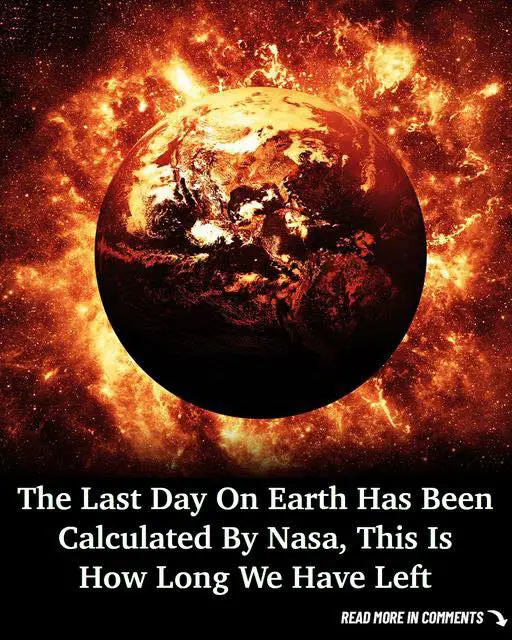Sharing is caring!
The Fate of Earth: A Scientific Perspective
NASA’s research has shed light on a sobering but scientifically fascinating topic—the eventual demise of life on Earth. While this event is estimated to be billions of years away, understanding the processes that will lead to Earth’s uninhabitability provides valuable insights into the lifecycle of our planet and the universe at large.
The Sun’s Role in Earth’s Future
The Sun, as the primary source of life on Earth, will also play a pivotal role in its eventual end. Currently, the Sun is in its main sequence phase, where it has maintained a relatively stable energy output for approximately 4.6 billion years. However, as it continues to age, its core will deplete its hydrogen fuel. This will trigger a series of transformations, causing the Sun to become hotter and more luminous.
In about 1.5 billion years, scientists predict that the Sun’s increasing energy output will cause Earth’s surface temperatures to rise significantly. As the planet warms, the oceans will begin to evaporate. This process will intensify the greenhouse effect, where water vapor, a potent greenhouse gas, traps even more heat in the atmosphere. This “moist runaway greenhouse effect” will render Earth’s climate inhospitable for life as we know it.
The Moist Runaway Greenhouse Effect
One of the most critical stages in Earth’s future demise is the moist runaway greenhouse effect. This phenomenon occurs when the planet’s atmosphere becomes saturated with water vapor due to excessive heating. The trapped heat will accelerate evaporation, leading to even higher atmospheric temperatures. As a result, Earth’s oceans will eventually boil away, leaving the surface barren and devoid of liquid water.
Without water, the foundation of Earth’s ecosystems will collapse. Plants, animals, and microorganisms that rely on water for survival will perish, marking the end of complex life on the planet. This stage could occur long before the Sun reaches its red giant phase, underscoring the importance of understanding how temperature changes impact Earth’s habitability.
The Red Giant Phase and Earth’s Ultimate End
Approximately 5 billion years from now, the Sun will exhaust its supply of hydrogen and begin fusing helium in its core. This marks the start of its red giant phase, during which the Sun will expand to engulf the inner planets of the solar system. While scientists debate whether Earth will be completely swallowed by the expanding Sun, one thing is certain: the planet will no longer be capable of supporting life.
If Earth is not engulfed, it will become a charred, lifeless rock, orbiting a dying star. The intense heat and radiation from the Sun will strip away the remaining atmosphere, leaving the planet exposed to the harshness of space. Over time, as the Sun transitions into a white dwarf, Earth will exist as a cold, desolate world, its vibrant history reduced to cosmic debris.
Implications for Humanity
While this apocalyptic scenario is billions of years away, NASA’s predictions have profound implications for humanity. These findings emphasize the necessity of exploring alternative habitats beyond Earth. The search for exoplanets—planets outside our solar system capable of supporting life—is driven by the understanding that Earth’s habitability is finite.
Efforts like the Mars colonization projects and space missions to study moons such as Europa and Titan highlight humanity’s desire to secure a future beyond Earth. These celestial bodies, with their unique environments, offer the potential for human survival in the distant future.
The Importance of Space Exploration
Space exploration is not merely about understanding the cosmos; it is a strategy for survival. By studying other planets, moons, and solar systems, scientists aim to identify environments where humanity could thrive when Earth becomes uninhabitable. Missions like the James Webb Space Telescope, designed to study distant exoplanets, are crucial in identifying worlds that may support life.
Additionally, understanding the life cycles of stars, including our Sun, enables scientists to predict the behavior of other stars and their potential impact on surrounding planets. This knowledge could inform the development of technologies and strategies for surviving or mitigating similar scenarios on other planets.
Lessons from Earth’s Future
While the prospect of Earth’s eventual demise may seem grim, it also serves as a reminder of the planet’s uniqueness. The conditions that make Earth habitable are extraordinarily rare and should inspire a greater commitment to preserving its environment for as long as possible.
Addressing climate change, conserving natural resources, and fostering global cooperation in scientific research are essential steps to ensure that humanity can thrive on Earth for as long as its environment remains supportive of life. By learning from the processes that will lead to Earth’s uninhabitability, we gain a deeper appreciation for the planet and a sense of urgency to protect it.
Hope for the Distant Future
Although the timeline for Earth’s end stretches billions of years into the future, NASA’s predictions inspire hope as much as they prompt reflection. Humanity’s ability to adapt, innovate, and explore suggests that life can endure beyond the confines of our home planet. By investing in space exploration and environmental stewardship, we take proactive steps to secure a future for generations to come.
Conclusion
NASA’s prediction of life’s eventual end on Earth is a sobering yet scientifically enlightening reminder of the transient nature of our planet’s habitability. While the processes leading to this outcome are slow and gradual, they underscore the importance of appreciating and safeguarding the fragile environment we inhabit today.
At the same time, this knowledge highlights humanity’s resilience and ingenuity. With continued advancements in technology and a commitment to exploration, humanity may not only survive but thrive, even as Earth’s days draw to a close. The story of Earth’s eventual demise is not just an ending; it is the beginning of a new chapter in humanity’s cosmic journey.
Sharing is caring!
![]()



























